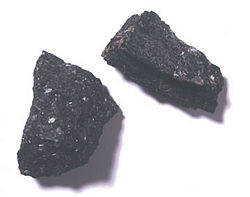Amphibole
Amphibole defines an important group of generally dark-colored, rock-forming silicate minerals. Some are constituents of igneous rocks, and others are part of metamorphic rocks. Hornblende is the most common subgroup of minerals in amphibole. Metallic ions found in different types of amphiboles include iron, magnesium, calcium, aluminum, and sodium ions.
Etymology
The name amphibole (Greek αμφιβολος/amfibolos, meaning "ambiguous") was used by René Just Haüy to include tremolite, actinolite, and hornblende. This term has since been applied to the whole group.
Characteristics
Amphiboles are composed of double-chain silicate (SiO4) tetrahedra, which are linked at their vertices. They generally contain ions of iron and magnesium in their structures. Amphiboles crystallize to produce two crystal systems: monoclinic and orthorhombic.
In chemical composition and general characteristics they are similar to the pyroxenes. The chief differences between amphiboles and pyroxenes are that amphiboles contain essential hydroxide ions, and the basic structure of an amphibole is a double chain of silicate tetrahedra, as opposed to the single chain structure of pyroxene. In addition, hand specimens indicate that amphiboles form oblique cleavage planes (with angles of around 120 degrees), whereas pyroxenes have cleavage angles of approximately 90 degrees. Amphiboles are also specifically less dense than the corresponding pyroxenes.
Amphibole groups
Numerous subspecies and varieties of amphibole are known, the more important of which are shown below. The formula of each is built on the general double-chain silicate formula RSi4O11. Yet the overall chemical compositions vary widely, as a result of which the different members show considerable variations in their appearance and properties.
Orthorhombic Series
- Anthophyllite (Mg,Fe)7Si8O22(OH)2
Anthophyllite occurs as brownish, fibrous or lamellar masses with hornblende in mica-schist at Kongsberg in Norway and some other localities. An aluminous variety, known as gedrite, and a deep green Russian variety containing little iron as kupfferite.
Monoclinic Series
- Tremolite Ca2Mg5Si8O22(OH)2
- Actinolite Ca2(Mg,Fe)5Si8O22(OH)2
- Cummingtonite Fe2Mg5Si8O22(OH)2
- Grunerite Fe7Si8O22(OH)2
- Hornblende Ca2(Mg,Fe,Al)5(Al,Si)8O22(OH)2
- Glaucophane Na2(Mg,Fe)3Al2Si8O22(OH)2
- Riebeckite Na2Fe2+3Fe3+2Si8O22(OH)2
- Arfvedsonite Na3Fe2+4Fe3+Si8O22(OH)2
- Crocidolite NaFe2+3Fe3+2Si8O22(OH)2
- Richterite Na2Ca(Mg,Fe)5Si8O22(OH)2
- Pargasite NaCa2Mg3Fe2+Si6Al3O22(OH)2
Hornblende is an important constituent of many igneous rocks. It is also an important constituent of the rock known as amphibolite, formed by metamorphism of basalt.
Actinolite is an important and common member of the monoclinic series, forming radiating groups of acicular (needle-like) crystals of bright green or grayish-green color. It occurs frequently as a constituent of greenschists. The name (from Greek ακτις/aktis, a "ray" and λιθος/lithos, a "stone") is a translation of the old German word Strahlstein (radiated stone).
Glaucophane, crocidolite, riebeckite and arfvedsonite form a somewhat special group of alkali amphiboles. The first two are blue fibrous minerals, with glaucophane occurring in blueschists and crocidolite (blue asbestos) in ironstone formations—both result from dynamo-metamorphic processes. The latter two are dark green minerals that occur as original constituents of igneous rocks rich in sodium, such as nepheline-syenite and phonolite.
Pargasite is a rare, magnesium-rich amphibole with essential sodium, usually found in ultramafic rocks. It is hard, dense, and black, with a red-brown pleochroism[1] when examined in thin section.
See also
Notes
ReferencesISBN links support NWE through referral fees
- Deer, W.A., R.A. Howie, and J. Zussman. An Introduction to the Rock-Forming Minerals. 2nd ed. Upper Saddle River, NJ: Prentice Hall, 1996. ISBN 0582300940
- Farndon, John. The Practical Encyclopedia of Rocks & Minerals: How to Find, Identify, Collect and Maintain the World's best Specimens, with over 1000 Photographs and Artworks. London: Lorenz Books, 2006. ISBN 0754815412 and ISBN 978-0754815419
- Klein, Cornelis and Barbara Dutrow. Manual of Mineral Science. 23rd ed. New York: John Wiley, 2007. ISBN 0471721573 and ISBN 978-0471721574
- Pellant, Chris. Rocks and Minerals. Smithsonian Handbooks. New York: Dorling Kindersley, 2002. ISBN 0789491060
- Shaffer, Paul R., Herbert S. Zim, and Raymond Perlman. Rocks, Gems and Minerals. Rev. ed. New York: St. Martin's Press, 2001. ISBN 1582381321 and ISBN 978-1582381329
External links
All links retrieved July 26, 2023.
- Amphibole Supergroup. Mindat.org.
Credits
New World Encyclopedia writers and editors rewrote and completed the Wikipedia article in accordance with New World Encyclopedia standards. This article abides by terms of the Creative Commons CC-by-sa 3.0 License (CC-by-sa), which may be used and disseminated with proper attribution. Credit is due under the terms of this license that can reference both the New World Encyclopedia contributors and the selfless volunteer contributors of the Wikimedia Foundation. To cite this article click here for a list of acceptable citing formats.The history of earlier contributions by wikipedians is accessible to researchers here:
The history of this article since it was imported to New World Encyclopedia:
Note: Some restrictions may apply to use of individual images which are separately licensed.
